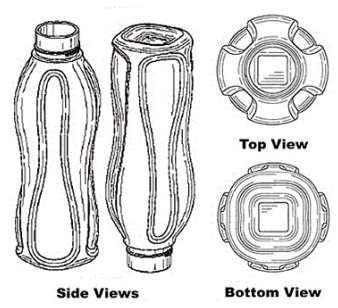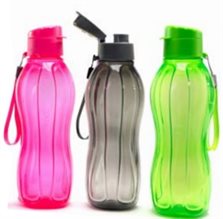
Subscribe & Follow
The message in a bottle shape - container trade mark disputes
With this in mind, we review the trade mark dispute between Dart Industries Incorporated and Another v Botle Buhle Brands (Pty) Ltd and Another [2022] (1 December 2022). As Judge Makgoka, who delivered this judgment, described it: “This is a trade mark dispute about a shape of a water bottle.”
Dart Industries Inc was the registered proprietor of a trade mark filed in 2015, registered for: ‘Household containers; kitchen containers; water bottles sold empty; insulated bags and containers for beverages for domestic use; beverageware; drinking vessels.’ It was endorsed as consisting of ‘a container for goods’, and was represented as follows on the trade marks register:

Tupperware Southern Africa (Pty) Ltd, and its South African representative and licencee in South Africa were the second Appellant. Tupperware had been selling a plastic bottle, in the shape for which it has been registered, as a trade mark since 2011, marketed as the ‘Eco Bottle’.

In 2019, Botle Buhle Brands started to market and sell the following bottle:

Tupperware approached the high court to restrain Buhle Brands from infringing its registered trade mark and sought a restraining order based on passing off.
In response, Buhle Brands launched a counter-application for the removal of Tupperware’s trade mark registration. Initially, the High Court found that Tupperware’s registered trade mark was neither inherently distinctive nor had acquired distinctiveness as a result of prior use, and Tupperware’s application was dismissed and Buhle Brands’ counter application was granted. This made it unnesessary for the High Court to decide the infringement issue or Buhle Brands’ other grounds. On deciding the passing-off issue, the court found that, although the bottles were virtually identical, taking into consideration the sales model used by both parties, there was no likelihood of deception or confusion.
The matter then went to the Supreme Court of Appeal (SCA), where the court first considered whether the shape of Tupperware’s Eco Bottle as a mark should to be removed from the register, specifically considering the bottle shape’s inherent distictiveness or acquired distinctiveness.
Inherent distinctiveness
In considering the question of whether Tupperware’s mark was inherently distinctive or not, the court had to consider that the function of a trade mark is to indicate the origin of the goods or services. (In the case of shape marks, the perception of the public is crucial. If the public relies on the distinctiveness of the shape as an indicator of the source of the goods, that then denotes the shape of a product as a trade mark.) The question therefore had to be asked, whether the public would perceive the container to be a badge of origin and not merely another vessel.
Tupperware contended that its Eco Bottle, ‘departs significantly’ from the shape of other water bottles in the market. They also claimed that the use of the specific hourglass shape with indentations was unique and unknown to the market at the time the bottle was launched in South Africa. The court then applied three steps in deciding whether the mark differed significantly from the norms and customs of the sector: Firstly, one needed to determine what the sector was. Secondly, to identify any common norms and customs of that sector and lastly to decide whether the mark departed significantly from those norms or customs. There was no evidence before the court that consumers appreciated that the bottle conveyed trade mark significance.
The court was not convinced that customers would consider the shape of the Eco Bottle alone as a guarantee that it was produced by Tupperware, as ‘containers and shapes generally do not serve as sources of origin.’ The SCA agreed with the High Court that the Eco Bottle did not have an inherently distictive character.
Distinctiveness as a result of prior use
There was no evidence before the court that the purchasers of the Eco Bottle perceive the shape of the bottle as an indicator that it originated from Tupperware. Tupperware also never marketed, promoted or sold the bottle with reference to its shape.
The Eco Bottle is also embossed with the Tupperware trade mark on its side and the court was of the mind that the public might rather perceive the bottle as originating from Tupperware because of the well-known embossed trade mark and not because of the shape of the bottle.
In conclusion, the court found that
the shape of Tupperware’s Eco Bottle did not distinguish it from water bottles sold by others and therefore was not distinctive, and the High Court was correct to uphold Buhle Brands’ counterclaim by ordering the cancellation of Tupperware’s registered mark.
Passing off
The court also had to determine whether Buhle Brands was passing off its water bottle as being Tupperware’s Eco Bottle. Passing off implies that in a representation by one person, that his business or merchandise, is that of another, or that it is associated with that of another’.
In passing-off proceedings, the court must consider many factors in determining whether there is a likelihood of confusion between products and brands. The court considered the shape, colour, material, and the caps of the bottles, as well as the placement of the respective ‘Tupperware’ and ‘Botle Buhle’ trade marks embossed on the side of the bottles.
Below are representations of the respective water bottles:


The requirements for a successful passing off action also require proof of reputation or goodwill, and a reasonable likelihood that members of the public may be confused into believing that the business of one is, or is connected with, that of another.
The Tupperware Eco Bottle had been promoted extensively in catalogues, newsletters and promotional leaflets. Considering the extensive and undisputed sales figures and marketing information, both the High Court and the SCA, found that Tupperware had established the necessary reputation in the Eco Bottle.
Both courts were in agreement that the bottles of both parties were ‘virtually identical’, with the only significant difference between the two competing bottles being the embossing of the words ‘Tupperware’ and ‘Botle Buhle’ on the side and cap of the bottles. The embossing was considered by the court to be “inconspicuous, and does little or nothing to distinguish the two products.” The High Court concluded that given the sales model, there was no likelihood of confusion. The High Court confined its enquiry, however, to Tupperware’s unique sales model - commonly referred to as ‘Tupperware parties’ - which includes the hosting of parties by a magnitude of consultants, predominantly at their homes.
Judge Makgoka remarked, quite firmly as follows: “It seems to me that the overall design of the Buhle Brands’ water bottle was not to distinguish it from that of Tupperware, but rather to associate the two. In other words, Buhle seems to have strained every nerve to associate its water bottle with the Eco Bottle.”
The Judge remarked that the enquiry whether a likelihood of confusion exists should extend beyond the Tupperware parties. Consumers may encounter the competing bottles at a party where both products are sold. Both the competing products were also marketed online, and in some instances catalogues of both products are depicted side by side. This, in the view of the court established the likelihood of confusion between the two products. It was therefore very likely that a customer would encounter the two competing bottles side by side and make an association between them – this is even more likely when making online purchases.
The SCA also remarked that, “This type of confusion, which results in consumers purchasing one product thinking that it is the one they know, or is associated with it, is at the heart of the action of passing-off.” The court found that the likelihood of confusion therefore did exist.
The third issue in passing-off is damage to a brand. Regarding damages, the court remarked that
by adopting the same marketing strategy as Tupperware, Buhle Brands had sought to associate its product in every respect, with that of Tupperware. This would enable Buhle Brands to trade its water bottle upon and benefit from the reputation of Tupperware’s Eco Bottle. The damage to Tupperware is inevitable.
Conclusion
This case is another great example of how shapes and containers (or even a combination of the two) clearly can serve a distinguishing function. It remains however, important for the owners of these shapes and shape trade marks to consider carefully the way in which they wish to protect their products and how they wish to distinguish their goods from those of competitors. It remains clear that relying only on shape as a trade mark can be tenuous and should be considered only part of a product’s identity.
About Pieter Delport and Juli Hopf
Pieter Delport - Associate, trade marks, Spoor & Fisher Juli Hopf - Partner, trade marks, Spoor & FisherRelated
Upcyclers - mind your IP and Qs when repurposing branded clothing 25 Feb 2025 Dupe or deal? Navigating counterfeit goods and scams this Black Friday 26 Nov 2024 Unpacking the Sol de Janeiro fragrance fiasco - what is the brand's legal recourse? 11 Oct 2024 The vital role of trade mark attorneys in building and protecting your brand 10 Oct 2024 Trademark dispute strips McDonald's of 'Big Mac' exclusivity in EU 30 Jul 2024 Know where to place your [trade] mark 12 Jul 2024 Protecting distinctive trade marks: Will Adidas have to change its stripes? 7 Jun 2024 Moral rights reserved? Impact of Creative Commons Licenses: part 2 2 May 2024







